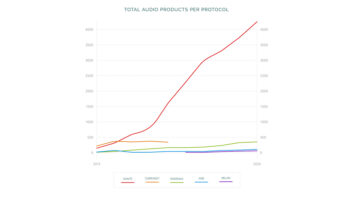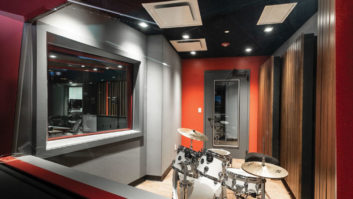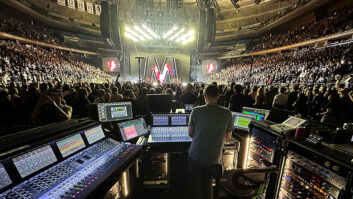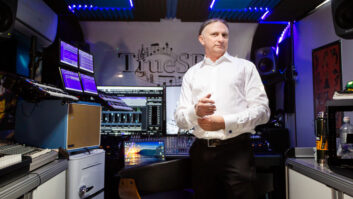Surely one of the great success stories of the past year has been the steady and impressive rise of Papa Roach, the hard-rocking alt metal/rap band from Vacaville, Calif. (near Sacramento). Their Infest album on the Dreamworks label has sold nearly three million copies worldwide and has propelled the group from playing small clubs in the Central Valley of California to headlining in theaters and arenas around the world in just a half a year. As usual, this is one of those “new bands” that has actually been together for seven years. But a hit album changes everything – and quickly.
The last nine months have been a whirlwind for the group, who have toured nonstop in every type of venue and every kind of tour imaginable. They’ve headlined clubs, opened an arena tour for Korn, played second on the bill for a recent tour with Limp Bizkit and Eminem, done the late-night TV circuit, the MTV Video Music Awards, a gaggle of multi-act radio station arena and shed shows, a fistful of European dates and they even got invited to the most recent Rock In Rio festival.
So you can imagine that it’s also been quite a year for Brendon Brown, who has been mixing the band live. Brown has known the guys in Papa Roach for many years; he was in bands in the Central Valley, and he also cut his teeth as a live engineer mixing sound at a Sacramento club called Harlow’s. Later, he got an offer to go on the road as the FOH mixer for another popular Sacramento-area act, Simon Says, and he found “that I liked touring a lot; I liked traveling and I liked the challenge of mixing in different places,” he says. “Right when I got back from Europe [with Simon Says], the Papa Roach album was getting ready to come out and I got a call from Brett, who’s their manager, asking if I wanted to go out on the road with them. We headed out together and then the record really started to take off, and here we are.”
It’s not surprising to learn that Brown’s approach to mixing this aggressive, elemental quartet – vocalist Coby Dick, guitarist Jerry Horton, drummer Dave Buckner and bassist Tobin Esperance – “is to keep it simple. I like to get a raw mix going quickly – get the band up and going and work from there. I try hard not to over-mix the band. Of course it’s heavy rock, but they also have a lot of hip hop feel to their music, in terms of the melodic bass lines and some of the drums, so I approach it like that with real heavy kick-snare-hat and the pounding bass underneath it. I have a couple of dbx 120 subharmonic synthesizers that I work on the kick drum and the bass to fill out the bottom end. It’s important to try to keep warmth and definition there.” In addition to the 120s, Brown’s personal FOH rack contains a BSS 901 parametric compressor that he chains with a dbx 160 for vocals, and an SPX 990.
Brown says that on the current tour, “I’m using all E-V mics except for a Shure SM91 on the kick, in conjunction with an [E-V] 868, to get a heavier attack. It works really well on the bigger shows we’ve done, like on the Korn tour, and in arenas. Also, Coby likes using either an SM58 or an E-V N/D 767a on vocals. But otherwise it’s all E-V, and I’ve been really happy with the way they’ve worked out. For the toms I’m using the new 468s, which are really nice because I go for a big, thick tom sound and those work well with the coated heads we use. On the snare top and bottom, I’m using the 478s, which I find are a little warmer than the regular SM57s so many people use. I also use the 478s on the guitar cabinets, left and right. For the bass mic, I use an 868 and then RE200s on all my condensers, which are hi-hat, ride and two overheads.
“I mix what they throw out at me onstage,” he continues. “But I also try to mix it a bit so it sounds like the record. It’s a conscious effort, because a lot of times you’ll see a band and it’s a great mix, but the vocals are too far out front. Coby doesn’t like to be way out front; he wants to be right there with the guitars. You want to be able to hear and understand the lyrics, but not at the expense of the guitars and bass.”
Generally, the band has not been carrying its own production, so Brown has worked on a lot of different FOH consoles the past year, and the group’s big sound has been pumped through everything from smallish club P.A.s to a full-blown Showco Prism system. “It made for a very stressful tour,” he comments, “but I’ve learned a lot. [Korn’s FOH mixer] Bill Sheppell really took me under his wing. Talk about a guy who can really mix – he schooled me on the dos and don’ts, as far as arenas go, so I got my game down there. But it’s tough. I don’t even have a monitor engineer. After we get the wedges up, we get a house guy to run the faders. It’s been a real challenge to work within the time restraints we’ve had on some of these shows – like on the radio shows [multi-act arena concerts sponsored by radio stations], you usually get about a 20-minute change-over – and to get everything up and slammin’ for when the band hits the stage.”
Brown’s fortunes are likely to improve as the band plays more headlining shows and embarks on tours where they will carry their own production. For now, there’s barely been time to come up for a breath. “I don’t think the full impact of what the record’s doing and how successful they really are has sunk in with the guys yet,” Brown says. “But they don’t seem like the kind of people who will be affected by that. They’re really good guys, and they’re really courteous to me and all the other crew guys. They take very good care of us. It’s a family. I would think it will only get better.”







